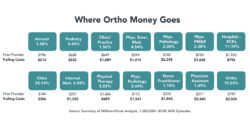June 16, 2022

Fixing America’s Aching Backs, Bones and Joints: Orthopedic Care in the Digital Health Era
Musculoskeletal (MSK) injuries constitute the fastest-growing disease category in the United States. More than half of all Americans (~54% annually, 127 million) suffer from muscle, bone, spine and joint disorders. [1] Almost half of those afflicted have chronic MSK conditions that require ongoing medical consultation and treatment. [2]
These conditions and disorders are increasingly costly. [3] MSK treatments account for approximately 10% of all U.S. healthcare spending. [4] Moreover, MSK conditions are the leading cause of employee days lost to illness or injury. Total productivity losses can be up to five times greater than treatment costs. [5]
MSK’s stratospheric costs and delays are largely driven by misdiagnosis, overtreatment, and prolonged interventions in traditional care settings. A host of innovative MSK companies now offer earlier, more accurate diagnoses and more appropriate, less invasive therapies. Consumers love these offerings. They resolve most MSK complaints, prevent surgeries, cost much less and deliver great customer service.
While in-person clinics are the primary modality for treating MSK conditions, digital MSK clinics are challenging their dominance. A battle for market share is underway. Hybrid (in-clinic/virtual) models compete with virtual-first care companies. MSK-only companies increasingly square off against virtual chronic care companies entering the MSK space. Given the size of the MSK addressable market, the winners are poised for massive potential growth.
As MSK care models mature, there will be fewer unnecessary scans, surgeries, and pain shots, as well as a significant reduction in the rate of growth of total spend. This is great news for healthcare consumers, payers, businesses and communities.
MSK Disorders and Costs
MSK-injury and MSK-disease risk increases with age as people lose bone density, flexibility, ligament and cartilage resilience, muscle strength and balance. Healthy lifestyles offset these risks, although aging boomers are also prone to sports- and activity-related MSK injuries.
 In the workplace, MSK injuries are highest in professions requiring physical labor, such as factory work, nursing and package/mail delivery, but MSK conditions also afflict white-collar workers. Sedentary work, bad posture and non-ergonomic office furniture trigger MSK maladies. Not surprisingly, COVID-related work-from-home has exacerbated the prevalence of MSK conditions.
In the workplace, MSK injuries are highest in professions requiring physical labor, such as factory work, nursing and package/mail delivery, but MSK conditions also afflict white-collar workers. Sedentary work, bad posture and non-ergonomic office furniture trigger MSK maladies. Not surprisingly, COVID-related work-from-home has exacerbated the prevalence of MSK conditions.
Employees suffering from MSK pain and immobility often miss work, are less productive and require expensive care over long time horizons. Failure to resolve MSK conditions makes individuals more vulnerable to subsequent illness and injury. The reduced mobility and weight gain associated with MSK conditions can induce or aggravate chronic illnesses and diminish health and quality of life. [6]
Roughly 75% of patients with MSK ailments receive treatment from primary care physicians (PCPs). [7] Contrary to best-practice protocols, almost 70% of PCPs order MRIs to diagnose MSK conditions. [8] When treatments are ineffective, and pain or injury persists, PCPs typically refer patients to specialists. Far too often these specialists perform costly and unnecessary surgeries and/or prescribe drug-related therapies that do not fix the underlying issue.
Under commission by Airrosti Rehab Centers, Koan Health analyzed over 2.1 million MSK episodes between 2012 and 2020 to detail initial and trailing treatment costs – defined as any cost associated with treating the MSK episode beyond the first provider. The diagram below details massive variation in total treatment costs.

While initial care costs for diagnosis and treatment by nonexpert providers are low, subsequent or trailing costs often soar. In contrast, lower trailing costs correlate with proactive initial treatments that resolve the patient’s MSK condition.
According to a 2019 study in JAMA, nearly 2.5 million US patients received lower-back or lower-extremity pain diagnoses between 2008-2015. Of those, only 1.2% received surgery, but these patients accounted for 29.3% of the total orthopedic spend. [9] Obviously, preventing unnecessary surgeries generates enormous savings.
MSK companies fall into two broad categories: those that combine in-person care with virtual diagnosis and follow-up care; and those that provide virtual care exclusively through digital clinics. Let’s examine each business model.
Airrosti: Virtual Diagnosis, In-Person Care, Virtual Follow-Up
With over 160 clinic locations in 4 states, Texas-based Airrosti has been a provider of in-clinic MSK care since 2004. It also provides virtual care through a digital MSK solution, Airrosti Remote Recovery (ARR), that is currently available in 47 states.
Airrosti employs its VIP (Virtual Injury and Pain) Chat portal to offer prospective patients a general consultation with Airrosti providers. This results in comprehensive orthopedic and functional exams and customized treatment plans. Airrosti delivers non-invasive manual therapies and rehabilitation exercises without pharmaceuticals, injections and/or surgeries to promote curative healing and reduce recovery time. If injuries warrant specialty care, Airrosti makes referrals to high-performing orthopedic practices.
Airrosti integrates its clinical services virtually through ARR. Licensed Airrosti providers diagnose via the ARR app and then ship a Remote Recovery Kit with therapy equipment to patients. ARR kits include individually-tailored treatments and customized exercises. Patients manage their care through videos and chat features on ARR.
CEO Mark Metcalfe explains how Airrosti’s treatment approach works:
Our goal is to get to the patient as early as possible and be the only provider that person sees so we can significantly reduce the total cost of care. If you intercept patients early and do a good diagnosis, you can often avoid an expensive image or unnecessary surgery, drugs, and referrals to other specialists.
Virtual care is almost as effective as in-person care, and it dramatically improves access. Metcalfe notes that virtual care, “takes a little longer – closer to four visits than three – but customer satisfaction and patient engagement remain exceptional.”
Airrosti works primarily with self-insured employers and commercial health plans under a fee-for-service arrangement. The company has been tracking outcomes and costs since inception and shares that data with clients. Metcalfe notes,
We’ve seen about 1.1 million cases over 18 years. And over that time, we’ve carefully collected patient outcomes and performed claims-based analyses to improve what we do. One of the things we focus on is trying to see a patient less. We often treat patients who have been struggling with an MSK condition and have been prescribed long-term care, including 10-20 visit treatment plans by another provider group. We try to do the opposite and work to get that patient fixed with as few visits as possible; we are constantly trying to improve treatment models and reduce episode length and costs.
On average, Airrosti’s MSK cases require just over three treatment visits and cost about $600 to diagnose and treat. Airrosti’s ability to meld its in-clinic and virtual capabilities exceeds patient expectations and differentiates Airrosti in the market. As Metcalfe puts it,
Our goal is not to be compared to other health care companies. We’re trying to create a patient experience that is unrivaled, not just in health care, but across the broader business universe.
Sword Health: Virtual-First Care Models
A convergence of new technologies (sensors, wearables, telehealth platforms) makes virtual MSK care practical today. Utilization rates are climbing as self-insured employers and commercial health plans see positive results in terms of reduced costs, faster rehab progress and increased convenience and satisfaction.
There has been significant investor interest in virtual MSK companies. Sword Health, founded in Portugal in 2015 and now based in Draper, Utah, raised $163 million in Series D funding in November 2021. [10] Sword’s investors include Sapphire Ventures, Transformation Capital, and General Catalyst. Its recent capital raise pushed Sword’s valuation to $2 billion. CEO and co-founder Virgilio “V” Bento credits the company’s rapid growth to its deliberate market strategy.
We spent years building the tech and clinical model before going to market. We didn’t launch until January 2020, but when we did, we saw crazy adoption rates because we have the most robust and sophisticated technology, we won’t compromise on clinical care, and we put our fees at risk.
Sword’s AI-powered digital therapeutic system enables interactive physical rehabilitation exercises from home, supervised by remote physiotherapists. Bento explains why the approach is effective.
MSK care is not rocket science. The gold standard is high-intensity, high-quality physical therapy. The problem is that physical therapists are scarce, demand for services is very high, and patients tend to fall off their treatment programs after just four sessions. But they still have pain, so they search for a silver bullet, which is typically surgery or opioids.
Most of the MSK spend in the US comes from surgeries, and 50% of those are unnecessary. The best surgery is no surgery. We’ve reinvented the gold standard with digital technology that allows you to access physical therapists in your own home. This, in my opinion, is the real promise of digital technology. Higher engagement, faster recovery, and dramatically lowers costs.
For Sword, at-risk contracts have helped drive its growth. Bento says:
Our clients are self-insured employers and commercial health plans who want to increase the quality, lower the costs and improve patient satisfaction. We walk the talk because we put our payment at risk by guaranteeing you’ll save more money than you spend, and if not, we pay you back. So, there is no risk for our clients.
Sword charges a case rate for each patient. After 12 months, Sword compares the customer’s total costs with a control group and provides refunds to clients who haven’t saved money.
Bento believes value-based payment contracts will transform orthopedic care services.
As we move from volume-based fee-for-service payment, which incentivizes surgeries, to value-based payment contracts, orthopedic surgeons will be incentivized to refer patients to Sword and vice-versa. So, we’ll have a bi-directional channel where value is the ethos on both sides. One of our key initiatives this year is to grow relationships with orthopods because we believe that appropriate bidirectional referrals represent the future of MSK care.
Sword is well-positioned to expand its service platform by developing offerings for ancillary sub-markets. For example, the company recently launched Bloom, a digital solution that addresses women’s physical health issues. [11]
Sword Health has formidable competitors in the virtual MSK care marketplace, notably Hinge Health. Based in San Francisco and founded in 2015, Hinge is the market’s leading digital MSK provider. The company offers virtual MSK care and physical therapy to employers and individual consumers. Hinge provides tablets and wearable sensors to guide users through workouts geared toward prevention, acute and chronic pain reduction, and rehabilitation. Consumers also can access one-on-one coaching via text, call or email.
With its recent $400 million Series E funding led by Tiger Global and Coatue Management, Hinge is the most valuable company in the virtual MSK space with a $6.2 billion valuation. Capitalizing on its first-mover advantage, Hinge has over 600 employer and health-plan customers. The company’s MSK solutions pairs clinical care offered by physicians, orthopedic surgeons, licensed physical therapists, and board-certified health coaches with digital technologies and services.
In contrast, Kaia Health is a virtual MSK company that partners with medical providers to create care teams. Founded in Germany in 2016, Kaia Health uses computer vision technology to digitize treatments with an app that helps patients perform exercises correctly by themselves. Unlike Sword and Hinge, Kaia’s platform treats a range of chronic diseases, such as COPD, not just MSK. Kaia’s technology is sensor-free and combines an app with an AI-coach.
Kaia recently raised $75 million in Series C funding via Optum Ventures, Eurazeo, 3VC, Balderton Capital, Heartcore Capital, Symphony Ventures, and A Round Capital. With strong growth in its US market, the company established a second headquarters in New York City.
Given the attractiveness of the total addressable MSK market, a number of digital-health companies have entered the virtual MSK space through acquisitions. They include:
- Omada Health, a digital health provider treating people with chronic health conditions ranging from diabetes, hypertension and mental health, entered the virtual MSK care market in May 2020 through its $30 million acquisition of Physera, a virtual physical-therapy provider.
- Dariohealth, a digital health provider for diabetes and hypertension, bought Upright Technologies in January 2021 for $31 million to expand into the digital MSK market.
- HealthJoy, an employee-benefits startup, entered the virtual MSK market when it acquired Rekinetics in April 2021.
Conclusion: Demand-Driven Change
Volume-driven, fee-for-service orthopedic medicine often balloons costs, prolongs treatment and worsens outcomes. Patients and employers deserve better. New MSK models are gaining market share by meeting demands for better, more holistic care at competitive prices.
Virtual care gives MSK providers scale, speed and data that informs market understanding and clinical optimization. Yet, questions remain. Though consumers are increasingly accustomed to virtual diagnoses and therapies, will they still want clinician-interaction at some stages of their treatment plan? Will MSK-only providers benefit from their singular focus or lose out to generalist virtual care providers that can meet broader market needs?
In the long run, the winners will succeed by stepping into the patient’s journey as early as possible and managing them to receive appropriate care through convenient, low-cost modalities. Many will operate under partial value-based or full-risk models and be accountable for outcomes and costs. Failure to meet or exceed expectations will turn investor enthusiasm into market peril.
The competition will drive further innovation in customer service and care delivery. Given the immense demand for MSK care, savvy investors can expect healthy returns in holistic, patient-focused MSK care companies. Employers and payers will see their costs fall. Patients will be the ultimate winners as they experience a faster return to pain-free, productive living.
Sources
- https://www.usbji.org/about/impact
- https://bmcmusculoskeletdisord.biomedcentral.com/articles/10.1186/s12891-020-03914-x
- https://www.optum.com/content/dam/optum3/optum/en/resources/PDFs/complex-conditions-whitepaper-final.pdf
- https://peerwell.co/blog/musculoskeletal-health-in-the-workplace-why-its-probably-your-biggest-issue/
- https://ergo-plus.com/cost-of-musculoskeletal-disorders-infographic/
- https://www.ncbi.nlm.nih.gov/pmc/articles/PMC3424705/
- https://www.boneandjointburden.org/2014-report/via21/health-care-treatment-visits-musculoskeletal-injuries
- https://www.ncbi.nlm.nih.gov/pmc/articles/PMC8119532/
- https://jamanetwork.com/journals/jamanetworkopen/fullarticle/2733180
- https://www.globenewswire.com/news-release/2021/11/22/2338893/0/en/SWORD-HEALTH-RAISES-163M-AND-REACHES-2B-VALUATION-AS-THE-FASTEST-GROWING-DIGITAL-MSK-COMPANY.html
- https://www.globenewswire.com/news-release/2022/03/08/2399092/0/en/SWORD-HEALTH-UNVEILS-BLOOM-A-NOVEL-APPROACH-TO-REDEFINE-WOMEN-S-PHYSICAL-HEALTH.html
Disclaimer
The information contained in this report was obtained from various sources, including third parties, that we believe to be reliable, but neither we nor such third parties guarantee its accuracy or completeness. Additional information is available upon request. The information and opinions contained in this report speak only as of the date of this report and are subject to change without notice.
This report has been prepared and circulated for general information only and presents the authors’ views of general market and economic conditions and specific industries and/or sectors. This report is not intended to and does not provide a recommendation with respect to any security. Cain Brothers, a division of KeyBanc Capital Markets (“Cain Brothers”), as well as any third-party information providers, expressly disclaim any and all liability in connection with any use of this report or the information contained therein. Any discussion of particular topics is not meant to be comprehensive and may be subject to change. This report does not take into account the financial position or particular needs or investment objectives of any individual or entity. The investment strategies, if any, discussed in this report may not be suitable for all investors. This report does not constitute an offer, or a solicitation of an offer to buy or sell any securities or other financial instruments, including any securities mentioned in this report. Nothing in this report constitutes or should be construed to be accounting, tax, investment or legal advice. Neither this report, nor any portions thereof, may be reproduced or redistributed by any person for any purpose without the written consent of Cain Brothers and, if applicable, the written consent of any third-party information provider.
“Cain Brothers, a division of KeyBanc Capital Markets” is a trade name of KeyBanc Capital Markets Inc. Member FINRA/SIPC.
KeyBanc Capital Markets Inc. and KeyBank National Association are separate but affiliated companies. Securities products and services are offered by KeyBanc Capital Markets Inc. and its licensed securities representatives. Banking products and services are offered by KeyBank National Association. Credit products are subject to credit approval. Copyright © 2022 KeyCorp.





